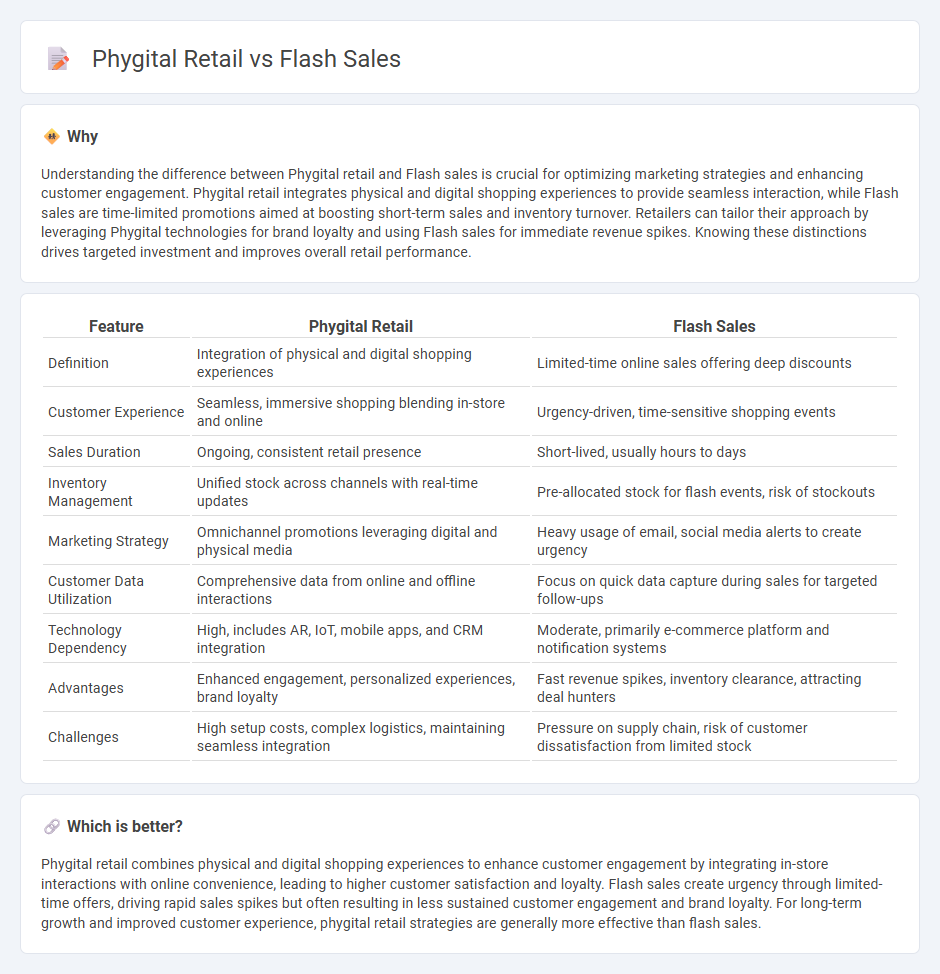
Phygital retail integrates physical and digital shopping experiences to enhance customer engagement and convenience, combining in-store interaction with online technology such as augmented reality and mobile apps. Flash sales create urgency by offering limited-time discounts, driving quick consumer responses and boosting short-term revenue. Explore how blending phygital strategies with flash sales can revolutionize retail dynamics and customer satisfaction.
Why it is important
Understanding the difference between Phygital retail and Flash sales is crucial for optimizing marketing strategies and enhancing customer engagement. Phygital retail integrates physical and digital shopping experiences to provide seamless interaction, while Flash sales are time-limited promotions aimed at boosting short-term sales and inventory turnover. Retailers can tailor their approach by leveraging Phygital technologies for brand loyalty and using Flash sales for immediate revenue spikes. Knowing these distinctions drives targeted investment and improves overall retail performance.
Comparison Table
| Feature | Phygital Retail | Flash Sales |
|---|---|---|
| Definition | Integration of physical and digital shopping experiences | Limited-time online sales offering deep discounts |
| Customer Experience | Seamless, immersive shopping blending in-store and online | Urgency-driven, time-sensitive shopping events |
| Sales Duration | Ongoing, consistent retail presence | Short-lived, usually hours to days |
| Inventory Management | Unified stock across channels with real-time updates | Pre-allocated stock for flash events, risk of stockouts |
| Marketing Strategy | Omnichannel promotions leveraging digital and physical media | Heavy usage of email, social media alerts to create urgency |
| Customer Data Utilization | Comprehensive data from online and offline interactions | Focus on quick data capture during sales for targeted follow-ups |
| Technology Dependency | High, includes AR, IoT, mobile apps, and CRM integration | Moderate, primarily e-commerce platform and notification systems |
| Advantages | Enhanced engagement, personalized experiences, brand loyalty | Fast revenue spikes, inventory clearance, attracting deal hunters |
| Challenges | High setup costs, complex logistics, maintaining seamless integration | Pressure on supply chain, risk of customer dissatisfaction from limited stock |
Which is better?
Phygital retail combines physical and digital shopping experiences to enhance customer engagement by integrating in-store interactions with online convenience, leading to higher customer satisfaction and loyalty. Flash sales create urgency through limited-time offers, driving rapid sales spikes but often resulting in less sustained customer engagement and brand loyalty. For long-term growth and improved customer experience, phygital retail strategies are generally more effective than flash sales.
Connection
Phygital retail merges physical and digital shopping experiences, driving real-time customer engagement and personalized offers through technology such as AR and mobile apps. Flash sales leverage this integration by creating limited-time, high-demand promotions that stimulate immediate purchases both in-store and online. The synergy between phygital strategies and flash sales maximizes consumer urgency, inventory turnover, and omnichannel revenue growth.
Key Terms
Limited-time offers
Flash sales generate immediate consumer excitement through limited-time discounts, driving high-volume sales within short periods. Phygital retail combines physical and digital shopping experiences, enhancing limited-time offers with immersive technology and seamless browsing across channels. Explore how integrating flash sales into phygital strategies can maximize customer engagement and boost revenue.
Omnichannel integration
Flash sales drive rapid inventory turnover through time-limited online offers, leveraging digital urgency to boost consumer engagement and sales volume. Phygital retail merges physical and digital experiences, integrating in-store technologies and online channels to create seamless omnichannel customer journeys that increase satisfaction and loyalty. Discover how combining flash sales strategies with phygital retail innovation can maximize omnichannel performance and transform consumer engagement.
Customer engagement
Flash sales create urgency by offering limited-time discounts, driving immediate customer engagement and boosting short-term sales volume. Phygital retail blends physical and digital experiences, enhancing customer interaction through immersive technology, personalized services, and seamless transactions. Explore how combining these strategies can optimize engagement and elevate the customer journey.
Source and External Links
What Is A Flash Sale? How to Run One and Examples (2025) - A flash sale is a limited-time discount or promotion designed to sell a large quantity of products quickly by leveraging urgency and fear of missing out (FOMO), often used during major shopping events like Black Friday Cyber Monday to boost revenue and customer loyalty.
What are flash sales? - Flash sales are short-term discounts with limited quantities that encourage impulse purchases and are effective for moving excess or out-of-season inventory quickly, sometimes forming the core sales strategy for businesses like Zulily.
Flash Sales - On platforms like Whatnot, flash sales let sellers offer Buy It Now listings at discounted prices for brief periods, with customizable settings for discount type, sale length, and purchase limits to maximize buyer participation and sales velocity.
 dowidth.com
dowidth.com